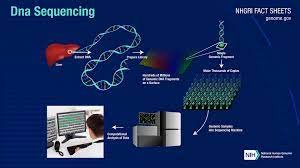
Prepare IAS Coaching
Current Affairs

Title : GENOME SEQUENCING
Date : Dec 04, 2021
Description :
GS II
Topic à Biotechnology and related issues
- About Genome Sequencing:
- The order of DNA nucleotides, or bases, in a genome—the order of Adenine, Cytosine, Guanines, and Thymine that make up an organism's DNA—is determined via genome sequencing.
- Genome of the Human:
- It consists of 23 chromosomal pairs and around 3 billion DNA base pairs.
- There are 24 chromosomes in humans, including 22 autosomal chromosomes and the sex-determining X and Y chromosomes.
- Chromosomes 1-22 are numbered in roughly decreasing order of size.
- Somatic cells typically include one copy of each parent's chromosomes 1-22, as well as an X chromosome from the mother and either an X or Y chromosome from the father, for a total of 46 chromosomes.
- Human protein-coding genes are thought to number between 20,000 and 25,000.
- The number of human genes has been reduced down from earlier estimates of 100,000 or more as genome sequence quality and gene discovery technologies have improved, and it is expected to continue to shrink.
- Genome Sequencing's Importance:
- The sequencing of the genome is a crucial step in understanding it.
- The genome sequence will be a helpful shortcut for scientists, allowing them to locate genes much more swiftly and easily. Even while scientists are still learning to understand these signs, a genome sequence does contain some information about where genes are located.
- Scientists also believe that being able to analyse the full genome sequence would help scientists better understand how the genome as a whole works—how genes interact to control an organism's growth, development, and maintenance.
- Finally, because genes only make up about a quarter of the DNA in the genome, knowing the full genome sequence will aid scientists in studying the parts of the genome that aren't genes. This comprises regulatory sections that regulate how genes are turned on and off, as well as extensive stretches of "junk" DNA, so named because its significance has yet to be determined.
- About the Human Genome Project:
- The Human Genome Project was an international research project aimed at determining the human genome's sequence and identifying the genes it contains. The National Institutes of Health and the US Department of Energy collaborated on the project.
- It was a 13-year, publicly funded initiative that began in 1990 with the goal of discovering the full euchromatic human genome's DNA sequence in 15 years.
- The Human Genome Project has been a resounding success. This effort not only ushered in a new era in medicine, but it also resulted in important advancements in the types of technology used to sequence DNA.
- Personalized medicine's goal today is to use information about a person's genes, including their nucleotide sequence, to produce medications that are better and safer.
- The Human Genome Project, for example, has resulted in the evolution of Her2/neu and Breast Cancer Treatment Response, as well as CYP450 and Antidepressant Response.
- Source à The Hindu à 03/12/21 à Page Number 2
